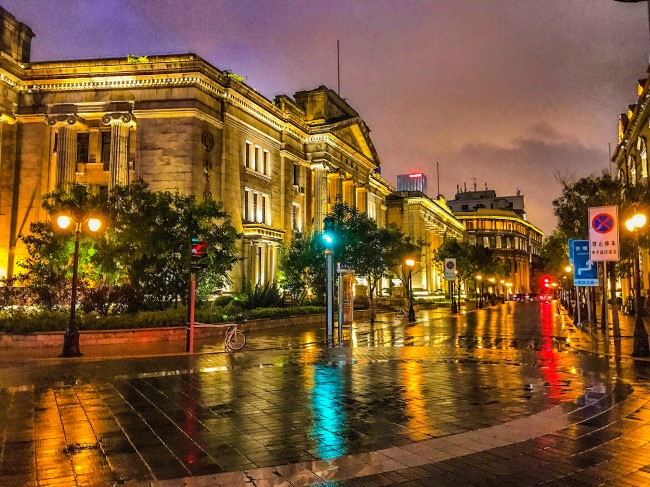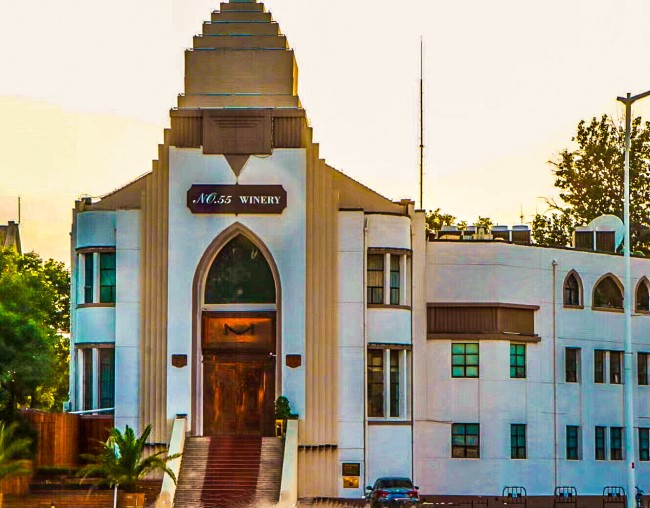Tianjin, a city today I hold with deep passion. Before coming to China 37 years ago, I knew nothing about the city. A situation unfortunately due to a devoid of information about the China within our educational curriculum. Returning recently to Scotland I remain saddened by this continual lack of knowledge. To generate an interest in Tianjin I would mention Paris 1924 Olympic Gold Medalist, Eric Liddell, known as the 'Flying Scotsman'. Born in Tianjin, he attended the University of Edinburgh before eventually returning to China. Liddell spent the remainder of his life in China, the country that he loved.
My first awareness of Tianjin was during the mid-1990's, travelling south by train from Beijing to Shanghai. Tianjin was first stop on that journey. Its relative closeness to Beijing resulting too often with bypassing the city in pursuit of more distant destinations.

Astor Hotel 2017 [Photo by Bruce Connolly]
When first experiencing Tianjin in 1996, I felt it had particularly unique characteristics. Its architectural heritage along with countless photogenic qualities presented a city I wished to document through the camera lens.
Over the years, by study and considerable exploration, I steadily developed an understanding of Britain's 19th century relationship with both China and Tianjin. The city became a focus of that country's desire to gain both a foothold and presence in China.

Classical architecture on Jiefang North Road 2004 [Photo by Bruce Connolly]
Tianjin has undergone a long history as an entrepôt, a transshipment point between the Grand Canal, Beijing and oceanic trade via the Haihe River and the Bohai Sea. The city, a maritime gateway for Beijing, was then a prosperous walled town centred on today's Gulou area. Part of its wealth grew through the lucrative salt trade. Today, not much remains of the early city, apart from street names. However, there is tranquil Tianhou Palace (temple), dating from 1326. It is located within the Ancient Cultural Street, close to both the canal and the Haihe River.

Haihe River from Shangro-La Hotel [Photo by Bruce Connolly]
By the early 1850's regular silting problems, affecting the canal, resulted in access to Tianjin via that waterway increasingly restricted. Consequently, Haihe's eastward flowing waters were becoming more attractive. Over time the river was straightened and dredged to facilitate larger boat passage. Close to where the Haihe reaches the Bohai Gulf, port facilities at Tanggu and Dagu steadily expanded. One of China's major container ports today is located there.
Britain's involvement with Tianjin commenced mainly from 1860. The 19th century witnessed considerable western interest in establishing a presence within China, often coercing this from an increasingly weak Qing government. Initially Britain and other countries had mainly shown interest in southern China, particularly the Pearl River Delta around Guangzhou (Canton). Considerable friction however built up there, between Britain and China, resulting in the First Opium War (1838-1842) and the Treaty of Nanjing. This involved ceding of Hong Kong to Britain and creation of five Treaty Ports along China's southern and eastern coasts.

Interior design of Kiessling Restaurant 2021 [Photo by Bruce Connolly]
The Second Opium War (1856-1860) led to the Treaty of Tianjin. Part of this permitted establishment of Foreign Legations (precursors of today's embassies) in Beijing. British and French concession districts were established in Tianjin from 1860. Eventually, there were nine such, although some only existed for a short period compared to the British lasting between1860-1942.
The events unfolding during this period were surely factors leading to growing unrest in China and eventual downfall of the Qing Dynasty.
The British concession expanded three times, becoming the UK's largest and certainly longest presence within the Chinese mainland. In Shanghai, the British concession lasted from 1845 to 1863, when it merged with the American concession to form Shanghai International Settlement.

Remaining part of former Gordon Hall, Jiefang Bei Road, 2004 [Photo by Bruce Connolly]
The British concession in Tianjin, was one of its seven in China. The initial area, of 28.26 hectares, was a strip of land on Haihe's west bank at former Zhilun village, near today's Ligonglou Bridge. It developed due to rapidly growing Sino-British trade as seen by the number of foreign boats then using the Haihe. The concession ultimately became Tianjin's trade and financial centre. The city's commercial activities, by late 19th century, were amongst the most valuable in China. Indeed that particular concession became Britain's most prosperous in China.

Jiefang Bei Road 2018 [Photo by Bruce Connolly]
Unlike Shanghai, Tianjin did not locate its major buildings along the waterfront or Bund. Instead, the Haihe riverbanks were bustling with docks, warehouses and many activities associated with international and coastal trade. Tianjin's prominent street was named Victoria Road (today's Jiefang North Road). Dating mainly from 1920's, pseudo-classical styled former western banks, financial and trading houses have today created an architectural treasure for the city. Many of them are now State-owned banks, often retaining elaborate historic interiors. Mostly well preserved they stand as a reminder of the grandeur that Tianjin emitted during that period. That road, in the 1920's, was regarded then as China's first Wall Street. Particularly by the early 20th century, parts of the city, such as this area, were developing outward looking lifestyles and ability to work with international business. Jiefang Bei is particularly charming at night, its buildings beautifully illuminated.

Tianjin Concert Hall, Xiaobailou 2021 [Photo by Bruce Connolly]
In 1897 the British concession expanded westwards, increasing by 1,630 acres. In 1902 it merged with the de facto American concession, now known as Xiaobailou ('Little White House'). Today it is home to some of Tianjin's outstanding buildings including Tianjin Concert Hall dating from 1922 (refurbished 2009). Famed for its live performances, its exterior is a popular location for wedding photography. Nearby, the city's first western-style restaurant, Kiessling, boasts a classic, historic interior within a 1920's Art Deco building. Across Nanjing Road stands Tianjin's iconic former Jewish synagogue built by Russian Jews in 1939.

Former Jewish synagogue at Xiaobailou 2022 [Photo by Bruce Connolly]
In 1903, the concession continued its growth, adding an extra 3,928 acres in what was known as British Extra Rural Extension. This included the delightful, residential areas of Wudadao ('Five Great Avenues') that could easily be within an upmarket English suburb.
By 1912, following the Qing government's collapse a steady movement of wealthy former officials and business leaders was heading from Beijing to Tianjin, taking up residence in Wudadao.

Minyuan Stadium 2024 [Photo by Bruce Connolly]
Many villas have plaques indicating who had lived there. One resident was Eric Liddell. In 1925 he helped design Wudadao's Minyuan Stadium. Today the stadium is one of the most popular landmarks in the city and home to several excellent restaurants within its walls. Wudadao attracts many visitors. It is a relaxing area for cycling along with sightseeing via its famed horse-drawn 'buses'.
By the end of the nineteenth century, Tianjin's population had grown beyond 2000,000 residents. Roughly half lived within the older 'Chinese' town. Conditions contrasted sharply with spacious living within the British concession. Again, another factor leading to considerable disquiet, particularly around 1900.
The centre for administration of the British concession was a grand building, Gordon Hall, named after General Gordon who surveyed the concession's original plot of land. It was mostly destroyed during 1976 Tangshan Earthquake whose impact also affected Tianjin.

Autumn at Jiefang Park [Photo by Bruce Connolly]
The hall stood where the Ritz Carlton hotel today now sits, overlooking Jiefang Park (known previously as Victoria Park). A small section of the hall still exists on Jiefang North Road. The park, although compact, is particularly attractive in spring and autumn. It is very popular with local people exercising daily.
The area around the park is also fascinating to explore. Directly north stands China's first modern-designed international hotel, The Astor, dating from 1863. During the 19th century, it was a prominent location for hosting diplomatic activities, as shown in its elaborate basement museum. It also held frequent dance parties. A regular there was Puyi, the last emperor, then residing within a Spanish-style villa in the former Japanese concession. The Astor boasts China's oldest elevator, an OTIS installed in 1924. Many rooms and corridors of its original building, still in use, create a feeling of a grand British country estate.

Former Kailuan Mining Bureau 2021 [Photo by Bruce Connolly]
Southwest of the park rises an impressive Greek revival-style building dating from 1921, the former offices of Kailuan Mining Bureau. In 2023 it reopened as Tianjin Financial Exhibition Centre.
Nearby at No1 Zhejiang Road, a spacious British-style villa was once the UK Consulate. Directly opposite is former All Saints' Church, creating an image as though in an English rural town. Dating from 1903, the present building, in traditional Gothic style, was completed in 1936, after a fire. Recently it has been elegantly restored into the Anglican Art Centre, increasingly popular for its exquisite musical recitals.

Interior of Anglican Arts Centre 2023 [Photo by Bruce Connolly]
The British concession, like much in Tianjin, changed after December 8, 1941. At the breakout of war in the Pacific, Japanese troops entered the concession and by February 18, 1942 it effectively ceased functioning. Most westerners in Tianjin were sent to Weihsien Internment Camp near Weifang in Shandong. Included with them was Eric Liddell who sadly passed away there on February 21, 1945.
After the war, what had been the remaining concessions were absorbed back into Tianjin administration proper and today are totally integrated parts of the city. However, they contribute to Tianjin's growing appeal, particularly for domestic tourism.
Despite its proximity to the capital, Tianjin retains a distinctive character partly due to the Haihe running through the city along with its unique architectural legacy of the concessions.





